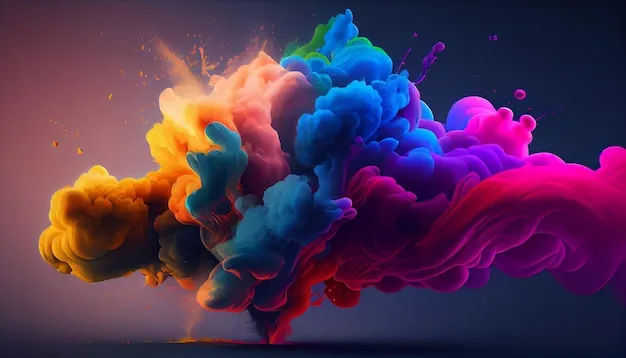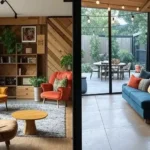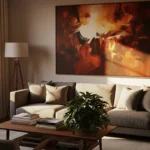You might not believe that colors have a massive impact on our thinking. Colors influence how we feel about any person, or any object near us. They impact our perspective of numerous items. They have an effect on our mood, and energy. Sometimes, even our behavior changes as a result of certain colors.
Let’s talk about where we can utilize this color psychology fo our benefit. Its in interior design, or simply any sort of designing. A room can either be dramatic or warm. To make your place feel as you desire, you must get a grisp on the color psychology of humans.
Here is a fact: every color has meaning. Some colors bring calmness, while some of these stimulate the exciting hormones of the body. You must select suitable shades that can make a big difference. It is not just about what looks good. You have to think about how a place will makes you feel. Let’s find out how you can use color psychology in your home.
What is Represented by Warm Colors?
Warm colors bring energy in your place. They give the illusion of a lively place that gives a pelasant atmosphere. Red,, and yellow are the primary warm colors. All of these colors have a unique effect in the mind and the eyes.
Red is bold and strong which grabs attention within seconds. This color increases energy and passion. It is suitable for dining rooms because it can stimulate appetite. In a living room, red is a adramtic addition that must not be voersaturated. Too much red will baffle the mind, and end up in frustration. Always utilzie it in small doses to maiaint balance in the atmoshpere.
Orange isa representation of warmth and fun. It feels friendly for anyone so its is in icnredble option for social places such as the living room. It makes people feel comfortable. In a home office, orange is known to skyrocket your creativity. You must be careful in using this because it is very vibrant.
Yellow is the color of sunshine which creates a happy and cheerful atmosphere. This color is suitable for kitchens and breakfast areas. You will notice yellow-painted areas as bright and uplifting. Yellow contributes to a positive focus. Keep in mind that very bright shades will feel too intense. Softer yellows work best for a calming effect on the mood.
What is Represetned by Cool Colors?
Cool colors are a synonyms of peace that icntantly gives you a relaxed feelinh. They bring relaxation and calmness. Blue, and green are the fundamental cool colors. Still the entire spectrum of cool colors have a special impact.
Blue is the most calming color as it cuts back the stress and brings tranquility into your life. This color is a special addition for any bedroom or bathroom. It contributes to a restful environment. Lighter shades will make you feel fresh and lively. On the other hand, darker shades of blue add more depth. Blue also enhances the focus. This is why you often find blue in offices.
Green represents nature. It is a sign of balance and renewal. This color gives the impression of freshness in the atmosphere, as you can feel in the outdoor elements of nature. It is a frequently demanded option for living rooms and bedrooms. Green works well in areas where people gather as it motivates comfort. Soft greens have a calming effect, while deep greens are a modern trend.
Purple has forever been linked to luxury as it was worn by the kings of old ages. Lighter shades feel soft and peaceful so they are recommended for bedrooms. Darker purples add drama and elegance in the air so this color has found its place in artistic spaces. It inspires imagination and deep thinking.
What about the Neutral Colors?
We must not forget the neutrals that are paramount to create balance in the design. You can use them with any design style. White, gray, beige, and brown are well-loved neutral colors which permit other colors to stand out. Without these neutrals, interior designing is left incomplete.
White reflects light, giving the illusion of an open and ventilated atmosphere, making the rooms look bigger. This color works in any part of the home and grants it a modern look. White is a part of modern and minimalist design.
Gray is the trending color of 2025. It is suitable for contemporary places where you want to reflect modernism. Lighter shades imply softness, while darker grays are dramatic. This color pairs well with bold accents to create an everlasting classic look.
Beige is a welcoming color that makes a place feel comfortable. This color is well-suited for cozy living rooms and bedrooms, where you demand a natural atmosphere. Beige pairs beautifully with wood shades and soft textures.
Brown is a grounded and stable color that brings warmth to any area. This color is great for furniture and flooring as the darkness gives richness to any design. Brown is appropriate for natural elements such as stone and leather.
How to Use Color Psychology in Different Rooms?
Before moving onto interior design, you must understand that any room in a home has a different purpose. You must select a suitable color to improve the function of every section.
Living rooms are the palace where guests will normally come and relax, and this is where you would be spending most of the day. It has to be welcoming. Warm and earthy tones are the top recommendations. You can find some softer shades of yellows, and warm beiges to give a sensation of comfort. If you demand a modern appearance, select the neutral colors with bold accents.
Bedrooms are where you go to relax after a hectic day, so they should be restful. Cool colors such as blue, and lavender are highly recommended. Plus, you can try soft pastels as they also represent relaxation. Darker shades are concerned with luxury appearance.
Let’s move onto the kitchens that should appear as lively and fresh. White, and lighter shades of green are appropriate, these colors make the area feel bright and open. Red color can be added for energetic feel but it should be subtle.
Bathrooms should feel clean and calming, so in this section you can select blue and white. These are the popular choices. Soft grays and greens also create a spa-like feel. If you desire a refreshing atmosphere of the bathroom, you should definitely try the shades of blue.
Do you have a home office? If yes, select any color that improves productivity and boosts the focus. Blue, and soft gray will work well. These colors improve concentration and decrease stress. Too many bold colors may be distracting, so always select a balanced combination of cool tones to create the best work environment.
We would recommend deep and darker colors for dining rooms. The spectrum of red and warm browns will encourage conversation and appetite. Deep blues and purples are a representation of luxury, while soft neutrals will create a relaxed dining setup.
How to Combine Colors for the Best Effect
Mixing colors can create a perfect balance as contrasting shades bring excitement. Similar tones will create harmony. Take notes that a well-planned color scheme makes a place feel cohesive.
A monochromatic scheme uses different shades of the same color, which will create a simple and elegant look. Light and dark variations add depth. A blue-themed bedroom with navy, and soft blue feels relaxing.
A complementary scheme uses opposite colors on the color wheel. This adds energy to a space. Blue and orange, or green and red, create strong contrasts. These combinations work well when one color is dominant and the other is an accent.
An analogous scheme uses colors that are next to each other on the color wheel. This creates a smooth and connected look. Blue, green, and teal together feel calm and natural.
Wrapping It Up!
Color psychology is a powerful tool in interior design that any homeowner must learn before investing in interior design. Selection of suitable colors will make your place appear even better. Warm colors attract energy, while cool colors represent calmness and create a soothing atmosphere. Neutral tones will balance the overall look. You must select colors according to the function of every room. For more epxert tips on decor and styling, explore our blog.





